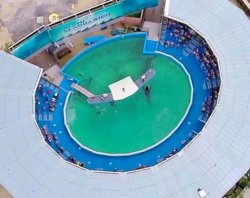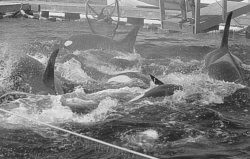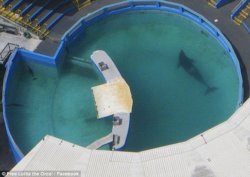Lolita/Tokitae: Fame and Misfortune (1966-2023)

In August 1970, when she was just four years old, the orca calf known as Tokitae was captured from her family, the “L” pod of the beloved Southern Resident Orca population, in the Salish Sea off the coast of Seattle in the Pacific Northwest. She was sold to the Miami Seaquarium for about $20,000. The following is a brief timeline of her life since then:
October 1970: At the Miami Seaquarium, Tokitae’s name is changed to “Lolita”, and she spends the next 52 years in the smallest orca tank in North America, 80 feet long by 35 feet wide, dubbed the “whale bowl”, performing for tourists. Through all those years, numerous groups and organizations dedicated to the protection of whales press for her return to her family and her home waters.
To the Lummi Nation of the Pacific Northwest, “Lolita” is Sk’aliCh’elh-tenaut, a member of Sk’aliCh’elh family of orcas who call the Salish Sea home. When leaders of the Lummi Nation call for her return, the Seaquarium argues that she is being well cared for and is an “ambassador” for her species. “She is not an ‘ambassador,’” Jewell James, director of the Lummi Nation’s Sovereignty and Treaty Protection Office, retorts. “She is a captive and must be reunited with her family. It is our ‘xa xalh xechnging’ [sacred obligation] to do this.”
June 2021: The United States Department of Agriculture, conducts a special inspection of the Seaquarium and issues a report stating that Seaquarium’s management has been deliberately ignoring the recommendations of its inhouse veterinarian:
“The facility’s attending veterinarian’s recommendations regarding the provision of adequate veterinary care and other aspects of animal care and use have been repeatedly disregarded or dismissed over the last year.”
In an interview with the Miami Herald, that veterinarian describes the many concerns she has raised for several years, including that she had warned management about poor water quality, bad food and other serious issues.
July 2021: At the request of, and under the guidance of, Lummi cultural advisors, experts from the Whale Sanctuary Project develop an operational plan to bring Tokitae/Sk’aliCh’elh-tenaut back from the Miami Seaquarium to her home in the Salish Sea, subject to regulatory approvals and receipt of government permits.
March 2022: The Dolphin Company, which manages parks in eight countries, purchases the Seaquarium and retires Tokitae from performance. The stadium itself has been condemned in the USDA report, meaning that only Tokitae’s caregivers are allowed within, and the CEO of the Seaquarium, Eduardo Albor, finds himself the new owner of an orca who cannot be displayed to the public and is being held at an unusable facility with a deteriorating infrastructure.
Meanwhile, Charles Vinick, executive director of the Whale Sanctuary Project, has begun discussions with Pritam Singh, entrepreneur, philanthropist and chairman of Sea Shepherd Conservation Society, with a view to engaging with Albor about returning “Toki”, as she is now widely known, to her home waters. Together they form a new organization, Friends of Toki, to help bring this about.
In January 2023, Jim Irsay, the billionaire owner of the NFL’s Indianapolis Colts, tells Vinick that when he was 12 years old, he had seen Tokitae perform and has never forgotten her. He says he is interested in helping take her back to her home waters.
March 2023: At a joint press conference with Miami-Dade County Mayor, Daniella Levine Cava, Friends of Toki, Jim Irsay and The Dolphin Company, the mayor announces that “For the first time ever, a private company with marine mammals under human care and an animal welfare organization, create a legally binding agreement with one goal – bring the opportunity to return Lolita, the sole killer whale at Miami Seaquarium, to her home waters – with all of these efforts supported by the generous financial contribution from a leading philanthropist, Mr. Jim Irsay.”
May 2023: As part of the agreement, independent veterinarians Dr. Stephanie Norman and Dr. Jim McBain initiate an independent assessment of physical and mental health of Toki. In June, they report that “beginning in late December 2021 and continuing into March 2022, just prior to the change of management of the Miami Seaquarium (MSQ) from Palace Entertainment to MS Leisure (The Dolphin Company), Toki suffered from an acute illness evidenced through her blood examinations and behavior monitoring. This was a very serious health event. Bloodwork results and responses to treatment confirmed this illness and the ongoing recovery.”
Over the following months, under the medical care of Drs. Norman, McBain and lead consulting veterinarian Tom Reidarson, along with the daily ministrations of the Seaquarium’s caregivers and members of the Whale Sanctuary Project team, Toki enjoys considerable improvements to her health. But there are fluctuations that are symptomatic of the underlying conditions deriving from 50 years of captivity.
August 18th, 2023: Friends of Toki posts the following:
“Over the last two days, Toki started exhibiting serious signs of discomfort, which her full Miami Seaquarium and Friends of Toki medical team began treating immediately and aggressively.
“Despite receiving the best possible medical care, she passed away Friday afternoon from what is believed to be a renal condition. Toki was an inspiration to all who had the fortune to hear her story and especially to the Lummi nation that considered her family.
“Those who have had the privilege to spend time with her will forever remember her beautiful spirit.”
Two months later, veterinary pathologist Dr. Judy St. Leger, a Diplomate of the American College of Veterinary Pathology with more than 20 years of experience in marine mammal pathology, publishes the report of the necropsy she has led on Toki. The report concludes:
“As animals age, degenerative conditions develop. This animal exhibited clinical progression of multiple degenerative changes with a cumulative impact resulting in death. The chronic cardiac valvular disease may have contributed to the lung disease (as is suggested by the presence of “heart failure cells” in the lungs). The ongoing inflammation and immune responses led to kidney disease from both immune protein deposition (amyloidosis) as well as tubular degeneration and mineralization, a typical aging change. The renal disease may have caused the gastritis and pituitary mineralization. Other findings may have been significant but with undetermined clinical impact.”
December 5th, 2023: In its Deep Reads feature section, the Washington Post’s Caitlin Gibson writes “The Call of Tokitae: After half a century in a tank, a beloved orca was about to be freed. Then her life ended, and a moment of reckoning began.”
The article begins “on the last day she saw her family, when the men came in spotter planes and speedboats, hurling seal bombs that sent 200-decibel blasts reverberating through the currents of Puget Sound” and concludes when Raynell Morris of the Lummi Nation “unlocked the cremation box and the seven people aboard the boat took turns scooping nearly 300 pounds of fine, dove-gray ash into the sea. They watched as the final essence of the whale vanished in the swells, borne out at last to open water.”
The following is Tokitae’s bio as originally posted on this website:
Lolita/Tokitae: Fame and Misfortune
Before she knew life under a blistering sun at a Miami theme park, the orca known as Lolita swam with her family off the coast of Washington State. Today, she is the most famous orca living in captivity.
In 1970, when she was just four years old, she was captured from her family, the “L”-pod, from the Salish Sea off the coast of Seattle in the Pacific Northwest and sold to the Miami Seaquarium for about $20,000.
Since that time, the Lummi Nation of the Pacific Northwest have continued to press for her return. To the Lummi, she is Sk’aliCh’elh-tenaut, a member of Sk’aliCh’elh family of orcas who call the Salish Sea home.
To the Seaquarium, Lolita represents a star money-making attraction despite years of protests by the Lummi and by other activists and animal experts who cite evidence that her living situation is legally and ethically unacceptable.
For people who object to the exploitation of intelligent animals for human entertainment, her situation represents a perfect storm of what’s wrong with keeping orcas in captivity. Indeed, few individuals have inspired people to care about and create change for captive cetaceans as has Sk’aliCh’elh-tenaut.
A plan for a better future
As part of our Whale Aid work, the Whale Sanctuary Project has drafted a comprehensive operational plan, grounded in and guided by Lummi ancestral wisdom as well as science, to safely bring Sk’aliCh’elh-tenaut back to her Xwlemi Tokw (her home) in the Salish Sea. The Xwlemi Tokw will be a secure and protected area within the Salish Sea where Sk’aliCh’elh-tenaut can thrive in her natal waters while receiving ongoing human care.
This operational plan was created in consultation with leading experts in marine mammal veterinary medicine, rehabilitation and husbandry, the lives and culture of the Southern Resident orcas of the Pacific Northwest, and the Salish Sea ecosystem. It addresses how to responsibly proceed with all components of Sk’aliCh’elh-tenaut’s return to her custom-built Xwlemi Tokw in the Salish Sea, while always prioritizing her wellbeing and the wellbeing of the Salish Sea ecosystem and all its inhabitants, including the Southern Resident orcas.
You can read more about the plan here.

Photo by Drones for Animal Defense

Lolita’s family being rounded up for capture
Sk’aliCh’elh-tenaut currently resides in the smallest orca tank in the United States. It measures just 80 feet long, 60 feet wide, and a shallow 20 feet deep. Experts note that her tank is so small that it violates the standards of the Animal Welfare Act, legislation that outlines the bare minimum of acceptable standards of care for animals held for exhibition and research.
When she first came to the Seaquarium, Sk’aliCh’elh-tenaut lived alongside Hugo, another orca captured from the same region, who had been captured two years earlier. They lived together for about 10 years until Hugo, after years of slamming his head against the sides of the tank and breaking his rostrum, died of a brain aneurysm in 1980.
Since Hugo’s death, Sk’aliCh’elh-tenaut has lived without the company of any other orca, a lonely life for a member of a family-oriented, social species.
Of all the whales seized during the infamous roundups of Southern Resident orcas half a century ago, Lolita is the only one still alive.
Would Lolita Remember Her Family?
In 1996, biologist Ken Balcomb of the Center for Whale Research recorded Sk’aliCh’elh-tenaut’s family greeting each other around the San Juan Islands, and reporters for NBC TV’s Dateline played the recording to her at the Miami Seaquarium. She appeared to recognize the calls:
Other challenges
When Hurricane Irma devastated the Miami coast in the September of 2017, Sk’aliCh’elh-tenaut was left abandoned in her tank, exposed to the treacherous elements, flying debris and potential power outages that could cause her tank to overheat and the filtration system to fail.

Lolita abandoned during Hurricane Irma, by FreeLolita
In June 2021, the United States Department of Agriculture (USDA) conducted a special inspection of the Miami Seaquarium. The report begins with the assertion that the Seaquarium’s management had been deliberately ignoring the recommendations of its inhouse veterinarian. The veterinarian later spoke with the Miami Herald about the challenges that Sk’aliCh’elh-tenaut faced at the Seaquarium. (Read more about this report here.)
How many more months or years must Sk’aliCh’elh-tenaut endure the cramped, tiny quarters of her tank that continuously put her health and safety at risk?
As animal advocates and Seaquarium officials continue to fight to determine her future, she continues to circle her tiny pool, still performing regularly for a paying public. She lives without the company of others of her kind.
At the Whale Sanctuary Project, we want Lolita to represent neither the promise of profit nor the ills of captivity. We want her to have the space and resources to be herself for the first time since she was four years old and only knew the protection and nurturance of her family – a family that still swims the waters of the Pacific Northwest where she was born.